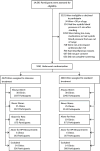Blood Pressure Measurement in SPRINT (Systolic Blood Pressure Intervention Trial)
- PMID: 29531173
- PMCID: PMC5967644
- DOI: 10.1161/HYPERTENSIONAHA.117.10479
Blood Pressure Measurement in SPRINT (Systolic Blood Pressure Intervention Trial)
Abstract
Recent publications have stated that the blood pressure (BP) measurement technique used in SPRINT (Systolic Blood Pressure Intervention Trial) was unattended. However, the SPRINT protocol does not address the issue of attendance. A survey was conducted immediately after SPRINT closeout visits were completed to inquire whether BP measurements were usually attended or unattended by staff. There were 4082 participants at 38 sites that measured BP after leaving the participant alone the entire time (always alone), 2247 at 25 sites that had personnel in the room the entire time (never alone), 1746 at 19 sites that left the participant alone only during the rest period (alone for rest), and 570 at 6 sites that left the participant alone only during the BP readings (alone for BP measurement). Similar systolic and diastolic BPs within randomized groups were noted during follow-up at the majority of visits in all 4 measurement categories. In the always alone and never alone categories, the intensive group had a similarly reduced risk for the primary outcome compared with the standard group (hazard ratio, 0.62; 95% confidence interval, 0.51-0.76 and hazard ratio, 0.64; 95% confidence interval, 0.46-0.91, respectively; pairwise interaction P value, 0.88); risk was not significantly reduced for the intensive group in the smaller alone-for-rest and the alone-for-BP-measurement categories. Similar BP levels and cardiovascular disease risk reduction were observed in the intensive group in SPRINT participants whether the measurement technique used was primarily attended or unattended.
Clinical trial registration: URL: http://www.clinicaltrials.gov. Unique identifier: NCT01206062.
Keywords: blood pressure; cardiovascular diseases; hazard ratio; hypertension; risk.
© 2018 American Heart Association, Inc.
Conflict of interest statement
Karen C. Johnson, MD, MPH - None
Paul K. Whelton, MB, MD, MSc - None
William C. Cushman, MD - Supported by Eli Lilly institutional grant, uncompensated consulting
for Takeda and Novartis
Jeffrey A. Cutler, MD, MPH - None
Gregory W. Evans, MA - Supported on an institutional grant from AstraZeneca AB
Joni K. Snyder, BSN, MA - None
Walter T. Ambrosius, PhD - None
Srinivasan Beddhu, MD - None
Alfred K. Cheung, MD - None
Lawrence J. Fine, MD, DrPH – None
Cora E. Lewis, MD, MSPH - None
Mahboob Rahman, MD - None
David M. Reboussin, PhD – None
Michael V. Rocco, MD, MSCE - None
Suzanne Oparil, MD - Research grant support from Actelion Pharmaceuticals/George Clinical;
AstraZeneca AB/Duke; Bayer; NIH/NHLBI, NHLBI; Novartis; Rox Medical Inc. Consulting for
Jackson T. Wright, Jr., MD, PhD - None
Figures
Comment in
-
Office Blood Pressure Measurement: The Weak Cornerstone of Hypertension Diagnosis.Hypertension. 2018 May;71(5):813-815. doi: 10.1161/HYPERTENSIONAHA.118.10850. Epub 2018 Mar 12. Hypertension. 2018. PMID: 29531176 No abstract available.
References
-
- Mozaffarian D, Benjamin EJ, Go AS, et al. American Heart Association Statistics C and Stroke Statistics S. Executive Summary: Heart Disease and Stroke Statistics–2016 Update: A Report From the American Heart Association. Circulation. 2016;133:447–54. - PubMed
-
- Nwankwo T, Yoon SS, Burt V, Gu Q. Hypertension among adults in the United States: National Health and Nutrition Examination Survey, 2011-2012. NCHS Data Brief. 2013:1–8. - PubMed
-
- Miura K, Daviglus ML, Dyer AR, Liu K, Garside DB, Stamler J, Greenland P. Relationship of blood pressure to 25-year mortality due to coronary heart disease, cardiovascular diseases, and all causes in young adult men: the Chicago Heart Association Detection Project in Industry. Archives of internal medicine. 2001;161:1501–8. - PubMed
-
- Lewington S, Clarke R, Qizilbash N, Peto R, Collins R, Prospective Studies Collaboration Age-specific relevance of usual blood pressure to vascular mortality: a meta-analysis of individual data for one million adults in 61 prospective studies. Lancet. 2002;360:1903–13. - PubMed
Publication types
MeSH terms
Substances
Associated data
Grants and funding
- UL1 TR000433/TR/NCATS NIH HHS/United States
- UL1 TR000445/TR/NCATS NIH HHS/United States
- UL1 TR000005/TR/NCATS NIH HHS/United States
- HHSN268200900040C/HL/NHLBI NIH HHS/United States
- UL1 TR000075/TR/NCATS NIH HHS/United States
- P30 DK079626/DK/NIDDK NIH HHS/United States
- UL1 TR000093/TR/NCATS NIH HHS/United States
- UL1 TR001427/TR/NCATS NIH HHS/United States
- UL1 TR000050/TR/NCATS NIH HHS/United States
- UL1 TR002240/TR/NCATS NIH HHS/United States
- UL1 RR024134/RR/NCRR NIH HHS/United States
- P30 GM103337/GM/NIGMS NIH HHS/United States
- UL1 TR001064/TR/NCATS NIH HHS/United States
- UL1 RR025752/RR/NCRR NIH HHS/United States
- UL1 RR025771/RR/NCRR NIH HHS/United States
- UL1 TR000439/TR/NCATS NIH HHS/United States
- UL1 TR000073/TR/NCATS NIH HHS/United States
- UL1 RR025755/RR/NCRR NIH HHS/United States
- UL1 TR002003/TR/NCATS NIH HHS/United States
LinkOut - more resources
Full Text Sources
Other Literature Sources
Medical



